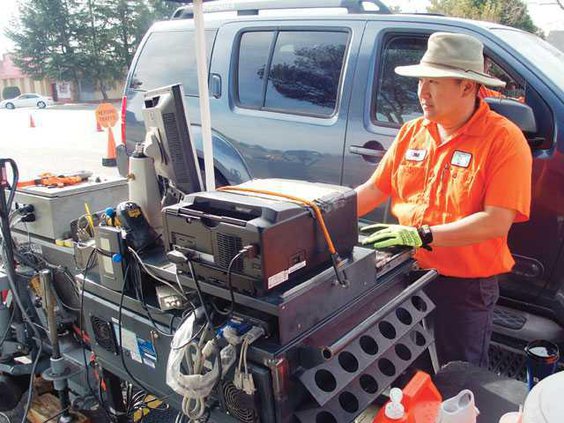Mike Dominguez didn’t quite know what to do with the paperwork that his father handed him.
And the story of what happened had him even more perplexed.
Here goes his mild-mannered father driving down Main Street, and all of a sudden he’s flagged down by a California Highway Patrol officer and ushered to a roadside area and handed a pamphlet. Not adept in English, the elder Dominguez didn’t quite know what was going on. Before he knew it his vehicle was being pulled up onto a strange-looking trailer.
One second he’s driving, and the next second his car is being smogged.
But while the situation might have been strange to Dominguez, it’s something that’s happening all over the state. Field technicians from the Bureau of Automotive Repair are conducting periodic and random field tests to determine the emissions of the more than 22 million registered vehicles on the road today.
“He didn’t know what was going on – he thought he was being pulled over and the next thing he knew they were handing them paperwork and he was driving away,” Dominguez said. “It freaked me out. I called the Manteca Police to try and find out what was going on, and they said that it wasn’t them and I wanted them to go out there and investigate it because I thought maybe it was a scam or something like that.
“You would think that it would be something that would advertise first to let people know that it was going on.”
But scaring motorists isn’t what the Bureau of Consumer Affairs – the Sacramento-agency that oversees the Bureau of Automotive Repair – was hoping to do when they set-up shop in Manteca Monday morning.
According to Information Officer Cristina Valdivia, field technicians are setting up somewhere in the state four-days-a-week, year-round. The entire process, she said, is voluntary, and is intended to allow the technicians to conduct a visual and tactical inspection of the vehicles that pass through and, periodically, perform some of the same tests that would be done during a smog check. That includes testing the gas cap, making sure the check engine light is off and inserting a testing rod into the tailpipe.
“It helps provide data about the cars that are on the road, and it’s information that doesn’t affect the driver or their vehicle at all,” she said. “It’s completely voluntary and we try to make that clear to people as they come through.”
The presence of a CHP officer was to provide traffic oversight. That particular agency was used because it was a State of California operation.
But Dominguez wasn’t the only non-native English speaker that was confused about what was going on.
Esther Villalpando apprehensively took the sheet that explained – in both English and Spanish – what the checkpoint was all about. The presence of a peace officer, she said, made her feel like she had to stop.
“I need to go pick up my son,” she said, watching as the technicians pulled her car forward. “I really don’t understand what this is.”
Valdivia said that the program requires that 20,000 vehicles are scanned every two years. That typically means somewhere between 30 and 39 cars pass through and agree to the process at a given stop.
The crew that started in Manteca in the morning was going to finish their day in Fresno.
Volunteer vehicle checks perplex Manteca motorists





